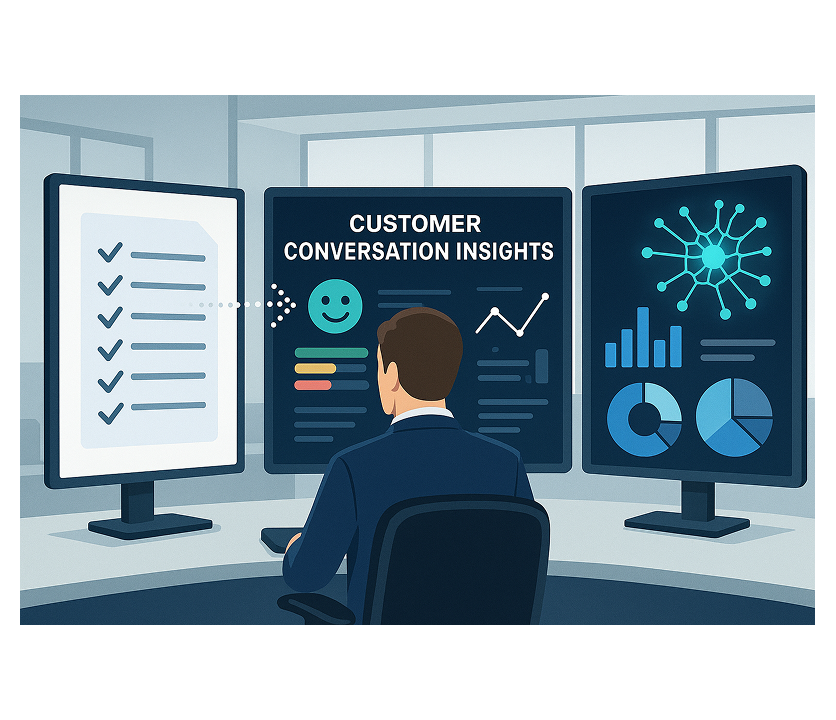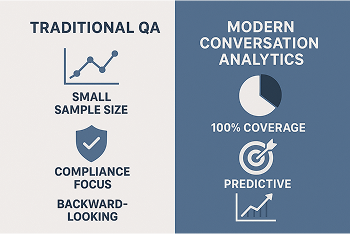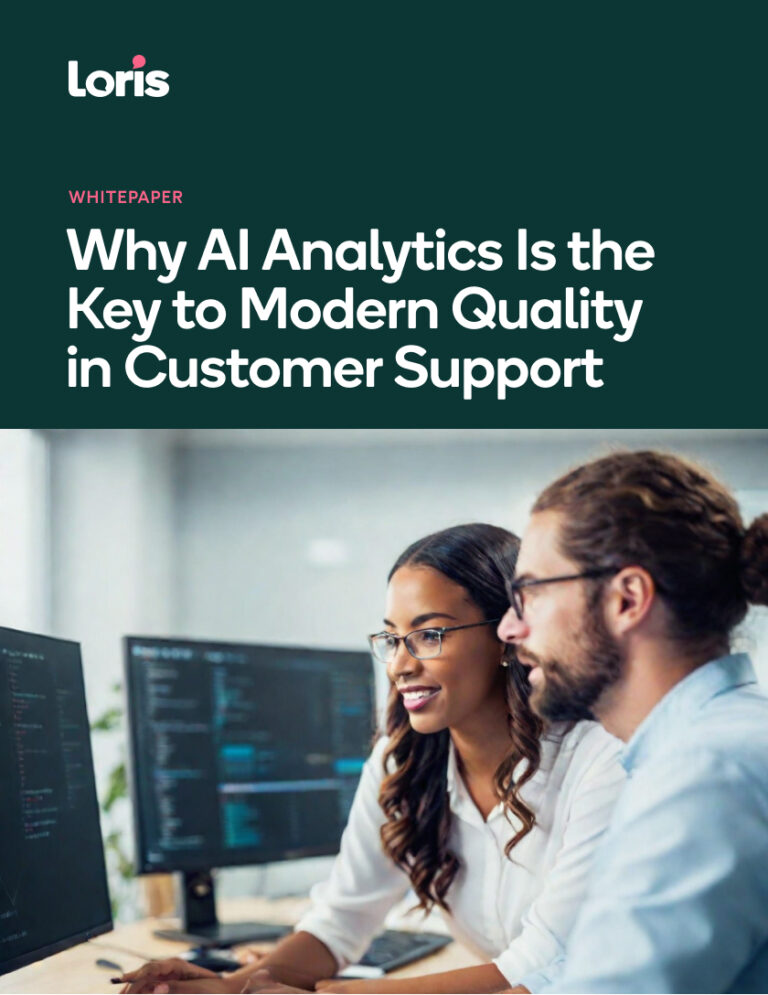
A Crisis Hidden in Plain Sight
If you’re leading a customer support team in 2025, your reality probably looks something like this: You’re being told to innovate using AI. And being asked why AI Agents can’t do half your team’s work. But you’re also running an operation that’s busier than ever. Dashboards are blinking red. Ticket volumes are unsustainable. And agent workloads are at levels that would have been unthinkable just five years ago.
If that weren’t enough, pressure from leadership remains relentless: make resolution times shorter, increase satisfaction scores, and lower operational costs. All simultaneously. How are you supposed to keep a good enough pulse on the day-to-day while also innovating in a once-in-a-lifetime shift?
So you jump to the first thing that you see that can stop the bleeding: AI, Automation, and just doing what you’re doing now, but faster. But is it really solving your biggest problem?
The AutoQA Illusion
Faced with these impossible demands, many support leaders reach for what seems like an obvious solution: AutoQA (aka Automated Quality Assurance). The promise is seductive – more comprehensive scorecards, broader coverage across interactions, and fewer human resources needed to maintain quality standards.
Initially, it delivers on its basic promises. Scores get calculated faster. Compliance violations get flagged automatically. The efficiency gains are real and immediate. But here’s where the story takes a familiar turn.
When the Honeymoon Ends
After the initial improvement in quality, as you would expect, the actual agent performance plateaus. Which is great if you’ve reached your agent performance goal. But most programs don’t see a meaningful improvement in actual customer satisfaction or business outcomes. And that’s because that’s not what QA does.
Why? Because QA answers one question: Which agents shouldn’t work here? If that’s the only problem you’re trying to solve, then great – QA or AutoQA will do that. But it’s not designed to answer questions like:
- Why are customers contacting us in the first place?
- Which conversations are leading to churn?
- Which agent behaviors actually drive retention or resolution?
- Where is automation helping, and where is it quietly causing frustration?
These are critical questions. But they’re not QA questions. And they require a fundamentally different approach.
Whitepaper: AI Analytics is the Key to Modern Quality
Learn why AI analytics are the natural starting place to understand your issues before you invest in QA, agent CoPilots, or even AI Agents.
Quality Checklists Don’t Build Loyalty
Most quality assurance programs are built around agent compliance metrics. Did the agent use the customer’s name? Was the case tagged correctly? Did they follow the mini-Miranda or escalation script to the letter? Would I have answered this better?
This approach has dominated customer service for decades, but it suffers from a critical flaw that, instead of being remedied over time, has become compounded. It’s a sign of how broken this system is that the most insightful thing is also the most obvious:
“QA Focuses on Your Agents, Not Your Customers”
Traditional QA focuses intently on what the agent did during the interaction. But it pays little attention to what the customer actually needed, besides possibly checking if the agent tagged the intent of the conversation correctly. Not only do most agents not tag these correctly – it also takes a ton of time and it’s even subjective for the QA analyst reviewing the interaction.
The biggest gap was highlighted in a Gartner webinar we wrote about a few months back. That organizations use QA as a way to get additional Voice of the Customer insight, but that it doesn’t collect or focus on the customer enough to reveal any valuable feedback.
Consider this scenario: An agent perfectly follows a 12-step troubleshooting script, receives a perfect QA score, and the customer hangs up frustrated because their real question was never addressed. The QA system celebrates adherence to the script and compliance with their necessary greetings and closings, but the customer needs are secondary.
Perhaps more critically, traditional QA operates in isolation from actual business results. This disconnect creates a dangerous illusion of progress. QA scores improve, managers feel confident about service quality, but customer satisfaction stagnates and churn continues to climb. Because your main focus was never on the one thing keeping your business going: your customers.

QA Leaves 98% of Customer Value Untouched
Here’s a staggering statistic that should reshape how every support leader thinks about their operation: most organizations sample only~2% of customer interactions for quality review.
That means 98% of your support conversations—complete with emotional context, friction points, unmet needs, and resolution patterns—are never analyzed, never understood, and never acted upon.
QA, aka Where Insights Go to Die
Even when conversations are reviewed, the insights rarely escape the QA silo. And this is by design. Because they only have value when looking at agent performance.
The result? Support and QA teams become experts at identifying the same problems over and over again, without ever fixing the underlying issues that create them. It’s world-class QA at the expense of customer experience.

The Intelligence Gap: What High-Performing Organizations Do Differently
The most successful support organizations in 2025 share a common characteristic: they’ve moved beyond treating QA as a compliance function and started using it as a strategic intelligence platform.
Ask Better Questions
Instead of focusing solely on agent behavior, high-performing support teams ask:
- What’s frustrating our customers at scale? They look for patterns of dissatisfaction across millions of interactions, not individual agent scores.
- Which moments in conversations cause satisfaction to drop or recover? They analyze the sentiment journeys, not just just aggregate scores.
- What are our top agents doing differently, and how do we systematically train that? They study success patterns, not just failure points.
- How can we reduce inbound volume without damaging the experience? They focus on fixing problems proactively, not just scoring how well agents react in the moment.
Build Systems of Continuous Learning
These organizations create feedback loops where insights from customer conversations directly inform:
- Product development priorities
- Self-service content strategies
- Automation design decisions
- Training program focus areas
- Policy and procedure updates
Why This Transformation Matters More Than Ever
Customer support has fundamentally evolved from a cost center to a strategic business function. It’s well-known that customers are willing to pay more for the experience qualities that matter most to them: 43% would pay more for greater convenience, and 42% would pay more for friendly service (PwC). What’s different now is that customers have so many more options, so retaining them and learning from them has become the new mandate of the support team.
But delivering on this promise requires more than operational efficiency—it demands strategic intelligence. Modern support leaders are expected to:
- Protect and grow revenue with proactive customer success initiatives
- Drive product innovation by surfacing user friction and unmet needs
- Optimize the entire customer journey by identifying and eliminating effort/friction points
- Predict and prevent issues before they impact customers
None of these objectives can be achieved through traditional QA approaches.
The Analytics Advantage: From Temperature Taking to Diagnosis
The difference between traditional QA and modern conversation analytics is the difference between a thermometer and a diagnostic engine.
Comprehensive Coverage
While traditional QA samples ~2% of interactions, AI-powered conversation analytics can process 100% of customer conversations in real-time, providing complete visibility into customer experience patterns.
Predictive AI Analytics
Instead of just measuring what happened, modern analytics platforms can predict outcomes. Loris worked with one client to tie sentiment to retention, giving them a clear signal of which customers are a churn risk and whether they should provide retention or appease discounts.
Root Cause Analysis
Rather than stopping at symptom identification, comprehensive customer analytics platforms trace issues back to their origins, whether they stem from product gaps, policy confusions, training needs, or process failures.
Outcome Correlation
Most importantly, modern platforms directly tie interaction patterns to business outcomes like retention, upsell success, and customer lifetime value.
The Current State: Massive Opportunity Ahead
Despite the clear benefits, adoption of comprehensive conversation analytics remains limited. According to McKinsey’s 2024 customer care survey, 57% of leaders expect call volumes to increase by as much as 20% over the next one or two years, yet only 25% of call centers have successfully integrated AI automation into their daily operations.
This gap represents a massive opportunity for organizations ready to make the leap.
Building Your Intelligence-First Support Strategy
Organizations ready to make this transition should focus on building capabilities in four key areas:
1. Comprehensive Data Capture
Move beyond sampling to capture and analyze 100% of customer interactions across all channels.
2. Pattern Recognition at Scale
Deploy AI systems capable of identifying trends, anomalies, and opportunities across millions of data points in real-time.
3. Outcome Integration
Connect conversation insights directly to business metrics like retention, satisfaction, and revenue impact.
4. Action-Oriented Workflows
Build systems that automatically route insights to the right teams with the authority and capability to address root causes.
The Loris Approach: Turning Every Interaction into Intelligence
Modern conversation analytics platforms like Loris are designed specifically to bridge this intelligence gap. Rather than simply automating traditional QA processes, they transform every customer interaction into a source of strategic insight.
Loris analyzes 100% of customer conversations, identifying:
- Emerging issues before they become widespread problems
- Your top issues on customer sentiment, not checklist compliance
- Product or policy gaps that are driving volume
- AI agent automation opportunities with the highest probability of success
Business Impact Focus
Every insight is tied directly to business outcomes, enabling support leaders to prioritize initiatives based on potential revenue protection, customer satisfaction improvement, or operational efficiency gains.
Cross-Functional Integration
Unlike traditional QA tools that serve only support teams, Loris creates feedback loops that inform product development, marketing strategies, and executive decision-making.
Conclusion: The Future Belongs to the Insightful
The customer support leaders who will thrive won’t be those with the fastest QA processes or the most comprehensive checklists. They’ll be the leaders who transform their support operations into intelligence engines, systems that not only resolve customer issues but actively prevent them, predict them, and turn them into opportunities for business growth.
The choice is clear: continue measuring temperature, or start diagnosing and treating the underlying conditions that drive customer experience.
The future belongs to those who choose intelligence over compliance, insights over scores, and customer outcomes over internal metrics.
Your customers—and your business—depend on making the right choice.
Related Questions
- What is the difference between AutoQA and Loris-style conversation intelligence?
AutoQA automates the traditional quality-assurance checklist—scoring agent compliance on greetings, scripts, and policies. Loris goes further: it analyzes 100 % of customer interactions to uncover why customers reached out, how sentiment changed during the exchange, and which moments drive retention, churn, or revenue growth. - Why don’t classic QA scorecards boost customer satisfaction?
Conventional QA is backward-looking and agent-centric. It grades whether an agent followed the script, but it rarely captures whether the customer got their real problem solved. As a result, QA scores can climb while CSAT, NPS, and reorder rates stay flat—or even decline. - How much data does Loris analyze compared with traditional QA programs?
Most support teams manually review about 2 % of interactions. Loris ingests and scores every call, chat, email, and bot session, giving leaders a complete, real-time view of emerging issues, sentiment swings, and quality patterns across the entire customer base. - Which insights does Loris surface from each conversation?
Loris has a prebuilt AI model library proven on more than 500 million customer interactions. These AI models include Contact Driver (the primary reason for contact), the true Root Cause that resolved—or failed to resolve—the issue, message-level sentiment and sentiment delta, Conversation Quality (predictive CSAT), and critical markers such as confusion, frustration, regulatory threats, profanity, and competitive mentions. - How does Loris connect support insights to hard business outcomes?
Every pattern Loris detects is tied to customer metrics that matter. Things like predictive CSAT and sentiment are obvious, but you can also tie these metrics to everything from lifetime value to churn risk to upsell potential. CX leaders have used Loris to see, for example, that calls with a positive sentiment delta lift 30-day reorder rates, while certain policy disputes spike churn among high-value customers (case study). - What are the first steps to build an intelligence-first support operation with Loris? Start by capturing 100% of interactions, using Loris to diagnose contact drivers and sentiment automatically. Integrate those insights with retention and revenue dashboards. Then route high-impact findings to product, operations, and training teams so issues get fixed at the source, not just scored after the fact.
